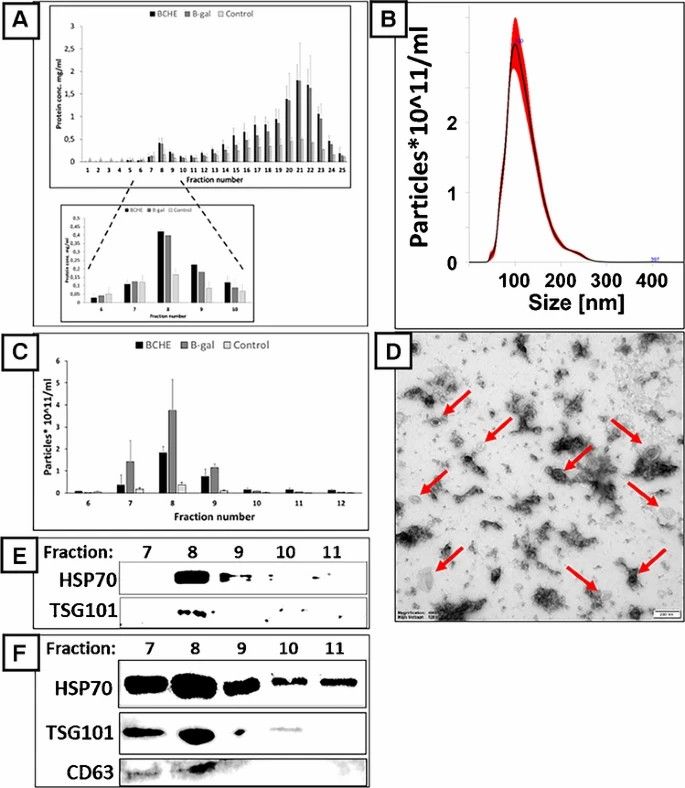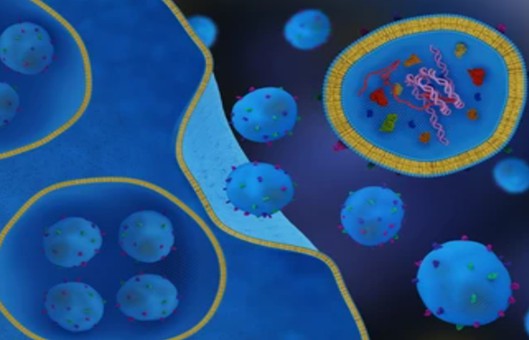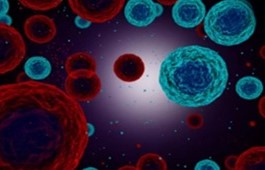Report of Protein Overproduction Inducing Exosome Secretion
Analytical and Bioanalytical Chemistry. 2023 Jul; 415 (16): 3167-3176.
Authors: Steć A, Targońska M, Karkosińska E, Słowik M, Płoska A, Kalinowski L, Wielgomas B, Waleron K, Jasiecki J, Dziomba S.
INTRODUCTION
Chinese hamster ovary (CHO) cells are the most widely used as an expression system for recombinant therapeutic protein (RTP) production, and nearly 70% of RTPs are currently generated by CHO cells, especially monoclonal antibodies (mAbs). Extracellular vehicles (EVs) are small lipid bilayer extracellular particles derived from cytoplasmic or endosomal membranes and are produced and secreted by a wide variety of different cells, including CHO cells.
The presented work aimed to investigate the impact of transfection on EVs production by CHO cells. It was verified whether the type of overproduced protein influences the intensity of EVs secretion as well as the physicochemical properties of vesicles.
METHODS
- Chinese hamster ovary (CHO) cells were maintained in a medium at 37°C with a humidified atmosphere of 8% v/v CO2 on an orbital shaker at 125 rpm. Cells were transfected with appropriate plasmid DNA after reaching 6×106 cells/mL cells' density. The cells were cultured according to the standard protocol for 8 days.
- The culturing media was centrifuged for 30 min at 3000 g at a temperature of 4°C. The retentate was fractionated into 25 fractions, 0.5 mL each, with an SEC column. The elution was conducted with PBS solution.
- We performed nano-particles tracking analysis (NTA) analysis. Samples were diluted in PBS to obtain around 40-100 particles per frame. A 305 nm laser and a camera were used to track particles. We perform capillary electrophoresis (CE) experiments with a system equipped with a photodiode array detector. The sample was injected hydrodynamically (5 s, 3.45 kPa).
- To determine β-galactosidase activity, 270 μL of reagent solution was mixed with 30 μL of a sample. The absorbance was measured with a plate reader at 420 nm wavelength in a time interval of 1 min. The BChE activity of each SEC fraction was determined spectrophotometrically by modifying Ellman's method using BTC (S-butyrylthiocholine iodide) as a substrate.
- Browse our recommendations
| Product/Service Types | Description |
| CHO cell line | Creative Bioarray provides high-quality CHO cell line products, such as CHO-SSR1 and CHO-SSR2, to enable the efficient production of biotherapeutic proteins. |
| Exosome Isolation and Purification | Creative Bioarray provides reliable techniques for exosome isolation from different sample matrices. We will perform QC assays to ensure the integrity and purity of the isolated materials. |
| Exosome Quantification | Creative Bioarray offers a range of options to meet most exosome quantitation demands, including but not limited to NTA. |
RESULTS
- Indeed, the BCA (bicinchoninic acid) protein assay revealed the presence of proteins in fractions 7th-9th. These fractions were also rich in particles with a modal size of about 100 nm and particle size distribution ranging from 40 to 270 nm. The size distribution of EVs in all analyzed isolates was found similar. WB analysis has finally confirmed the presence of exosome markers HSP70, TSG101, and CD63 whose concentration peaked in fractions 7th-9th. Significant amounts of proteins were detected in fractions from the 10th to 25th. Similar conclusions were drawn from CE analyses.
 Fig. 1 The analysis of fractions obtained with SEC from the culturing medium of CHO cells transfected with vectors overexpressing BChE (black bars); β-Gal (gray bars) and un-transfected control; (light gray bars).
Fig. 1 The analysis of fractions obtained with SEC from the culturing medium of CHO cells transfected with vectors overexpressing BChE (black bars); β-Gal (gray bars) and un-transfected control; (light gray bars).
- High enzymatic activity of later eluting fractions (12th-23rd) obtained from culturing media of cells expressing BChE and cells translating β-Gal which confirmed the effectiveness of the transfection process and the overproduction of the protein. However, cholinesterase activity in EVs-rich fractions (7th-9th) was found negligible and accounted for <0.5% of summary enzymatic activity measured in all SEC fractions. Interestingly, a significant β-Gal activity (7.2 ± 0.7% of total activity measured in all fractions) was found in fractions 7th-9th. The measured activity correlated with the EVs content in these fractions.
SUMMARY
Our results revealed that a protein overproduction might induce EVs secretion, which might be accompanied by the sequestration and loading of overexpressed proteins into the exosomes. These findings are of vital importance for the manufacturing of therapeutics in CHO expression systems due to the risk of product loss during downstream processing of culture medium as well as the application of exosomes as nanocarriers of therapeutic proteins. The study indicates also the importance of culturing process control.
RELATED PRODUCTS & SERVICES
Reference
- Steć A, et al. (2023). "Protein overproduction alters exosome secretion in Chinese hamster ovary cells." Anal Bioanal Chem. 415 (16): 3167-3176.

